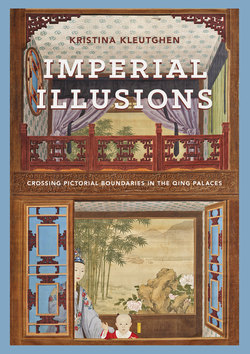Читать книгу Imperial Illusions - Kristina Kleutghen - Страница 27
На сайте Литреса книга снята с продажи.
ОглавлениеWish-Fulfilling Studio archives reveal that in addition to numerous locations within the Forbidden City, scenic illusions were originally installed across the full range of imperial sites in and around Beijing, including but not limited to imperial palaces, residences, gardens, and parks. The Central and South Seas (Zhongnanhai) park located just west of the Forbidden City may still hold scenic illusions in situ,43 but it is now the Chinese government center, with no access whatsoever granted to scholars. The Perfect Brightness Garden complex (Yuanmingyuan) is located in the northwest corner of Beijing, six miles from the Forbidden City, and was originally both a garden retreat and a fully functional alternate government center for a dynasty that disliked spending time in the Forbidden City. Its name now refers to the complex of multiple neighboring gardens in this area of Beijing, including the Eternal Spring Garden (Changchunyuan), although these were conceived and constructed separately in the eighteenth century. Today both the Perfect Brightness Garden and the Eternal Spring Garden lie in ruins, but originally they may have contained the greatest number of scenic illusions. Nearby, paintings were also installed at the southern-style Carefree Spring Garden (Changchunyuan), where Qianlong’s mother (the empress dowager Xiaosheng [1693–1777]) lived, and at the Fragrant Mountain (Xiangshan) retreat west of the Perfect Brightness Garden.44 “Travel palaces” (xinggong) housed the emperor on his many imperial tours throughout the empire, and scenic illusions were installed there as well. At the Mount Pan travel palace (Panshan) outside Beijing, for example, a complete program of wall and ceiling paintings was installed at the Attracting Victory Pavilion (Jingshengxuan).45 Scenic illusions were even installed 150 miles outside Beijing at the imperial summer residence at Chengde, known as the Mountain Retreat for Escaping Summer Heat (Bishu Shanzhuang).46 These few locations are only the most important and best known of the sites with scenic illusions, which could be found essentially anywhere Qianlong spent time, and especially in places that were important to him.
For various reasons, the vast majority of scenic illusions have been lost, along with their original locations. The skills necessary to create and repair these works largely died out with the core group of Qianlong’s Chinese and European Wish-Fulfilling Studio artists.47 Many works were likely destroyed in the political upheavals of the late nineteenth and early twentieth centuries. Any scenic illusions still mounted in the Perfect Brightness Garden in 1860 would have been looted, ruined, or lost in the conflagration set by marauding foreign troops during the Second Opium War (1856–60). Although archives demonstrate that the Forbidden City’s Established Happiness Palace (Jianfugong) also had scenic illusions, the fires that eunuchs set there in 1923 to hide evidence that they were stealing from the imperial collection would have destroyed any paintings still in situ. Today, most of the paintings in situ are in Qianlong’s Forbidden City retirement compound, the Tranquil Longevity Palace (Ningshougong). The delicate condition of all the extant paintings demonstrates their extreme vulnerability to damage from having been installed permanently or for long periods of time, suffering from exposure to the
